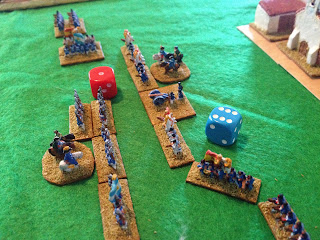 |
| A view from the church as the musketry commences |
In the battle roughly 2,500 Royalist troops under General Pio de Tristan formed up in front of the town of Salta, and were attacked by about 2,700 Patriots under General Belgrano. Using 'Liberated Hordes' the forces worked out as follows:
Royalists
5 x Regular Infantry
1 x Regular Skirmisher
3 x Militia Infantry
2 x Militia Cavalry
1 x Militia Artillery
Breakpoint: 6 elements
Patriots
9 x Regular Infantry
2 x Regular Cavalry (Gaucho)
1 x Militia Cavalry
1 x Regular Artillery
Breakpoint: 7 elements
The rules for Skirmishers are described in this post. In addition I tried out two new rules:
(i) Infantry which received rear support pursue after close combat if it's their bound and their opponent is Artillery or Infantry. (Attack columns are impetuous, basically)
(ii) Cavalry could be designated as 'Gaucho'. This meant that it pursues if it wins a close combat with an unmodified die-roll of 4+ (instead of 5+ for other cavalry. In addition, if gaucho cavalry loses a close combat with an unmodified die-roll of 1 or 2 it flees 600p instead of recoiling.
On paper the Patriots have everything going for them - a one element advantage in numbers, an advantage in cavalry and far fewer militia elements.
This is how the armies deployed. The hills counted as bad going.
The Patriots.
The Royalists.
A view from the town of Salta itself.
The Patriot cavalry immediatey attacked their Royalist counterparts, and routed them. With their left flank turned a rapid Patriot victory was on the cards.
The Royalist infantry on the left flank fell back in order to try and hold off the Patriot cavalry. Meanwhile their right advanced; the Patriots had concentrated on their right and in the centre, hoping to break through the Royalists with a rapid advance. Their left flank was a little exposed. Maybe it could be turned before the Patriot cavalry destroyed the rest of the Royalist army.
The lines closed.
The Patriot left was covered by an element of infantry, which faced off the Royalist skirmishers, and the Patriot artillery. But a deadly volley of musketry wiped out the gunners, and the artillery was lost.
In fact deadly Royalist volleys were the order of the day. A Patriot infantry element fell.
And another.
And another ...
The Patriot cavalry pressed home their advantage ...
... but were shot down by another deadly Royalist volley.
It wasn't all bad for the Patriots. Under Genera Belgrano's direct command, the Patriots fixed bayonets and charged the Royalist line, breaking it.
General Belgrano had every reason to feel confident at this stage.
At this point the Patriot army looked to General Belgrano for some some inspirational leadership. They looked in vain - a 1 for PIPs meant that he could only sit and watch the Royalists out-manoeuvre his army.
Yet another deadly volley of musketry saw an element of Patriot infantry rout, and that was it; the army was defeated.
The end of the battle; although the Patriots had broken through in the centre, they were stalled against the Royalist left, and their own left was dangerously compromised.
The initial Patroit advance had been aggressive, and in an ideal world should have swept the Royalists away. But both armies rolled badly for PIPs just as the lines closed. This meant that the battle stalled into an exchange of musketry and the Royalists rolled ridiculously well, destroying element after Patriot element. Their attack blunted there was little the Patriots could do, and a final bad PIP roll sealed their fate.
Here are the Patriot losses.
And the Royalist ones.
It was only when looking at the losses that I realised I'd made a mistake. I'd forgotten to deploy one of the Royalist cavalry units, so they'd actually fought, and won, the battle with only eleven of their twelve elements. Oops.
In these pictures General Pio de Tristan accepts General Belgrano's surrender.
A contemporary painting, and not a result of me playing around with Photoshop filters in any way, shape or form. Well - maybe a little ...
In terms of testing new rules I didn't get that much opportunity. The Patriot gaucho cavalry either won with high rolls such that they would have pursued anyway, or routed rather than recoiled. And there was only one close combat featuring rear-support. The column did win, so pursued, but it didn't really have any effect on the game one way or the other. Still, I shall test them in further games.
























Nice report, an interesting battle!
ReplyDeleteQuite a seesaw of events making for an exciting battle. Nice idea making the columns impetuous.
ReplyDelete